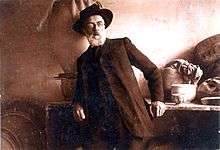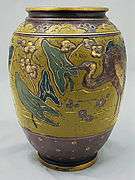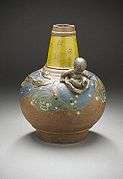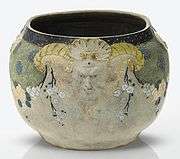Ernest Chaplet

Ernest Chaplet (1835 in Choisy-le-Roi – 1909 in Hauts-de-Seine) was a French designer, sculptor and ceramist. His works are held in international public collections such as the Musée d'Orsay, Paris.
Having worked in industry for over 30 years, he opened an atelier with the sculptor Albert-Louis Dammouse in 1882, producing stoneware often influenced by Japanese designs[1] and Chinese prototypes. From 1875 he worked with Félix Bracquemond.[2] Chaplet became head of the Parisian workshops of Charles Haviland in 1882, and worked on ceramics with Paul Gauguin from 1886;[3] together they created some 55 stoneware pots with applied figures or ornamental fragments, multiple handles, painted and partially glazed.[4] He later worked with Jules Dalou and Auguste Rodin.
From 1887 Chaplet took up permanent residence at Choisy-le-Roi, often collaborating with the ceramics manufacture Alexandre Bigot. He won acclaim at the 1900 International Exhibition,[2] but lost his sight in 1904, after which his son Emile Lenoble took over his studio. He committed suicide in 1909.[5]
Gallery
-

Ibis vase
-

Vase, c 1881-1887
Notes
- ↑ "Ernest Chaplet". jasonjacques.com. Retrieved 10 October 2015
- 1 2 "Ernest Chaplet". Metropolitan Museum of Art. Retrieved 10 October 2015
- ↑ Benicka, 154
- ↑ Metropolitan Museum of Art timeline. Retrieved 10 October 2010
- ↑ The Connoisseur: An Illustrated Magazine for Collectors, Volume 192. Sampson Low, Marston & Company, 1976. 246
Sources
- Benicka, Corinne. Great Modern Masters. Bookthrift, 1980. ISBN 978-0-8967-3047-2
- D'Albis, Jean. Ernest Chaplet. Knowledge Press, 1976
- Thiébaud, Philippe. La Revue du Musée d'Orsay, nr 2, February 1996, Paris
